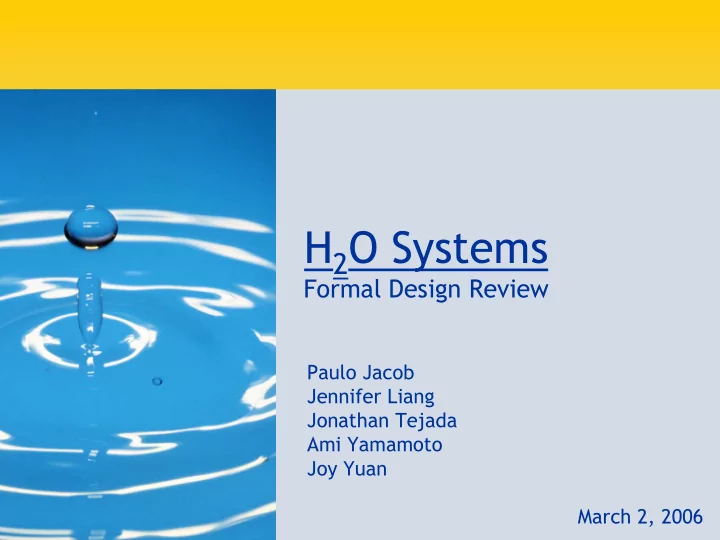

H 2 O Systems Formal Design Review Paulo Jacob Jennifer Liang Jonathan Tejada Ami Yamamoto Joy Yuan March 2, 2006
Background • Current Water Disinfection Methods – Chemical Treatment: Chlorine and Ozone • Problem: Formation of hazardous intermediates and high operating costs – Thermal Treatment • Problem: Energy input, change in flavor and temperature limitation • Drinking Water Standards Maximum Contaminant Potential health effects from Contaminant Level (mg/L) exposure Cryptosporidium 1% Gastrointestinal illness Giardia lamblia 0.1% Gastrointestinal illness Legionella No limit* Legionnaire’s Disease Viruses (enteric) 0.01% Gastrointestinal illness
Electroporation • Definition: – A process that uses high voltage impulses to create micropores in a cell membrane. • Mechanism: – Local instabilities arise from dielectric breakdown • Separation of charge on either side of membrane → Membrane grows thinner → Pore is created → Cell lyses = bacteria dies
Project Outline • Purpose: To create an small device that efficiently treats water supplies contaminated with disease causing bacteria • Method: Electroporation to lyse bacteria cells • Formation of pores in the cell membrane from exposure to high voltage electric fields • Design: Centimeter scale parallel plate electrodes with contaminated water flowing through micron scale gap
Materials Selection • Input/output of water • Biological samples • Device components – Clear PVC tubing, 1/8” – Polyester shim stock, 12.5 to 500 µm – Polyurethane glue – Polypropylene Luer lock fittings – Syringes – Electrode
Candidate Electrode Materials • Stainless Steel – Susceptible to corrosion under certain conditions – Economical • Ti – Superior mechanical properties – Established electrode material – Corrosion resistant oxide layer • Wide band gap semi-conductor stable in solution • Enhanced by anodizing – Difficult to machine • Water jet cutting
Anodizing • Surface treatment – Forms up to 100 nm layer of TiO 2 • Resistivity of 10 12-18 Ohms*Cm • Enhanced corrosion & wear resistance • Method – SAE specification AMS 2488 – Titanium employed as anode in electrochemical cell – Stainless steel counter-electrode – Caustic electrolytes (e.g. NaOH) – Thickness tuned by voltage
Voltage Limitations: Effective Lysing E = 1~5 x 10 5 V/m Electric Field required for lysis: Our goal: low voltage input V = Ed Aiming for a voltage input of around 12 V , we find that a gap distance of d = 25 µm is required. Verhes. Water Research, 2002.
Dielectric Considerations • Dielectric strength – Air: 3 x 10 6 V/m Ti – TiO 2 : 4-8 x 10 6 V/m TiO 2 – Water: dependent on ionic content H 2 O • Partially filled capacitor treatment
Voltage Limitations: Concerns • Dielectric reduces electric field by a factor of dielectric constant • E=E 0 /K • Dielectric constant of pure water: 80 • Given initial voltage (12V), E=6x10 3 V/m which is less than required to lyse bacteria (1~5 x 10 5 V/m) • Necessary potential difference would be 1000 V to achieve lysing electric field.
Pressure Limitations Surface Tension Couette Flow (2 parallel plates) 3µLQ T(W+2 δ ) ∆ P = ∆ P = 2W δ 3 W δ T = surface tension of water = 72.0 dynes/cm (25°C) µ = viscosity of water = 0.01 Poise Q = flow rate = 1 liter/hour 2 δ = electrode gap distance = 25 µm W = width of flow area L = length of flow Based on these two equations, we find that dimensions of L = 10 cm W = 2 cm yield a reasonable pressure difference (under 2 atm) that allows us to achieve our target flow rate.
Design Proposal
Design Proposal Anodized Ti Anodized Ti water in water out water in 2 cm m c 0 1 25 µ m Power Supply Final Design shim stock Ti Ti water out PVC tubing
Testing bacteria • Water samples from Charles river – Simultaneous assessment of bacterial content of experimental and control samples • Pre-Treatments – Filtration – Dilution – Deionization
Issues & Concerns Potential Problems Possible Solutions Electrolysis of water AC current Fouling Filtration, revise size scale Surface roughness tolerance Alter device dimensions Safety (electricity, infectious agents) Maintain high safety standards Budget Efficient use of materials, time Elimination of variables Testing protocol, further theoretical investigation and modeling Timeline Rigorous adherence to deadlines
Gantt chart 4/27- 5/11- 2/9-2/22 2/23-3/15 3/16-4/5 4/6-4/26 5/10 5/18 Research Design Material Acquisition Construction Testing Modification Final Presentation Preparation
Questions? h2o@mit.edu
Recommend
More recommend